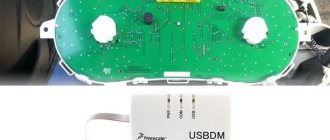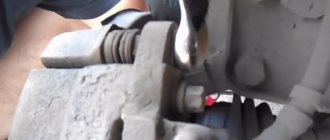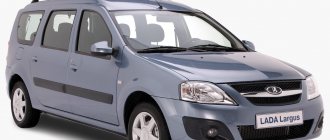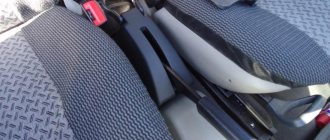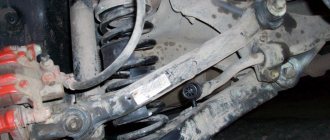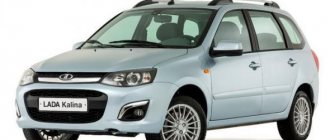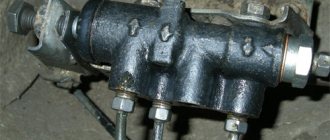see also
Brake cleaner
- 4 2 16k
Uneven pad wear
- 27 1 20k
Pads squeak when braking
- 171 1 154k
Brakes jerkily
- 68 0 74k
Why do brake pads squeak?
- 82 1 89k
Lada Kalina cars of both generations have front disc brakes and rear drum brakes.
As original front brake pads for Kalina 1, the catalogs indicate 21100-3501080-00 and 21100-3501080-01, for Lada Kalina 2 the article number is 11180-3501080-00. The same catalog numbers are used for Lada Priora. Factory brake pads TIIR
Rear drum brake pads are specified as 21080-3502090-01 or 11180-3502090-10 (with ABS) for Kalina 1 and 2.
Many of these part numbers are invalid; instead, online parts stores offer other original part numbers or equivalents. This makes sense, since in the case of the Lada Kalina (and LADA in general), the original is often inferior in quality to its substitutes .
| Front disc brake pads Lada Kalina | ||
| With dimensions - length: 104.4 mm; width: 62.1 mm; thickness: 17. mm. | ||
| Manufacturer | Catalog number | *Price, rub.) |
| Brembo | P41003 | 780 |
| ** Ate | 13046029652 | 703 |
| Ferodo (Premier) | FDB527 | 640 |
| Hankook Frixa | FPE103 | 626 |
| NiBK | PN0223 | 536 |
| TRW | GDB469M | 495 |
| Ferodo (Target) | TAR527B | 405 |
| Lada | 21083501080 | 380 |
| Finwhale | V218 | 363 |
| Allied Nippon | ADB0173 | 330 |
The most popular brake pad analogues are Ate, Brembo, TRW, TSN, Finwhale and Ferodo. The latter are divided into two types according to the color of the box - “red” and “green”. “Green” ones, with the prefix Target in the name, are positioned by the manufacturer as an improved replacement for factory pads , but they are not intended for heavy loads. Red, with the prefix Premier, are considered premium pads that can withstand extreme loads.
The best-selling disc brake pads for Lada Kalina are products from Ate, followed by Brembo and TRW. Drum brake pads for Kalina are most often purchased from TSN due to its favorable price. They are slightly inferior in popularity to TRW and Ate pads.
| Rear drum brake pads Lada Kalina | ||
| With dimensions - diameter: 200 mm; width: 41 mm. | ||
| Manufacturer | Catalog number | Price, rub.) |
| Ferodo | FSB240 | 860 |
| Ate | 03013702312 | 815 |
| Sangsin | SA183 | 715 |
| TRW | GS8210 | 672 |
| Finwhale | VR318 | 658 |
| Bosch | 0986487813 | 610 |
| Profit | 50010240 | 650 |
| Allied Nippon | ABS1701 | 612 |
| Trialli | GF231 | 547 |
| TSN | 232 | 460 |
The brake pads indicated here are also suitable for other VAZ cars: 2110, 2114, Lada Granta and others, with R13 and R14 brake discs.
Front brake pads are replaced approximately twice as often as rear brake pads. The exact frequency of replacement is quite difficult to establish, but the front pads are changed at intervals of 30-50 thousand km, and the rear pads at intervals of 60-90 thousand. To more accurately determine when Lada Kalina brake pads need to be replaced, it is worth checking the thickness of the friction linings every 15,000 km. A thickness of about 2 mm is considered critical.
Drivers are often motivated to change brake pads on Kalina by squeaking brake pads. Special plates installed on the disc brake pads from the outside help significantly combat this. That's what they call them - anti-squeak plates . Such plates can often be found in more expensive brake pad sets. However, you should choose brake pads not based on the presence or absence of anti-squeak plates, but on the basis of reliability and braking efficiency.
*The price of Lada Kalina brake pads is given as of April 2017 for Moscow and the region. **Bold indicates those pads that are most popular in a particular case.
When to replace
The pads must be replaced periodically.
The replacement time depends on driving style, braking and some other criteria. Experts have identified recommended parameters from which to build. The brake system of the Lada Kalina should be checked every 15 thousand km. Much depends on the car’s drive: if it is front-wheel drive, then the elements in this part need to be changed more often. If a person likes to drive fast with intense braking, then the disc elements will have to be reanimated every 5 thousand km.
If you have drum plates, you don't have to worry about their condition. They will work quietly for 150 thousand km. The vacuum brake booster must be changed whenever a hissing sound appears.
How to determine when brake fluid needs to be replaced? Everything is simple here: when braking, the plates begin to make a characteristic sound. It can come either from the elements themselves or from the wear sensor.
It is necessary to periodically check the condition of the friction material. You also need to pay attention to the brake fluid level. As the plates wear, it increases.
Which VAZ brake pads are better to choose?
In 2020, there are a large number of companies on the market selling components and consumables for Lada cars. Depending on the car model and the store’s assortment, the choice of brake pads can reach 4-5 varieties. The main division is based on brands and production materials. The list of the best manufacturers includes:
- EzATI;
- VATI;
- MARCON
- ROSDOT
- STS
These companies have held leading positions in the list of the most popular brands for several years in a row and guarantee high quality products.
Also, some motorists prefer original spare parts. AvtoVAZ brake pads differ from analogues in their moderate cost and optimal efficiency. At the same time, the manufacturer does not recommend the use of serial versions for aggressive use for other purposes. Such actions can overheat the linings, which will cause the brake fluid to boil and cause the module to fail.
Material selection
The material of the brake pads also differs. A large selection of organic, ceramic and semi-metallic mixtures often confuses the motorist, which provokes him to make the wrong choice.
Organic
The modification is the oldest variety. The first pads were made from organic material. The modification is designed to work under moderate loads. Typically, this variety is used on production vehicles for daily use in urban environments. The advantages are moderate cost and sufficient prevalence. Disadvantages include rapid wear and low efficiency at high loads.
Semi-metal
The next subtype is used primarily on modified cars and is intended for more aggressive use under increased loads or high speeds.
Among the advantages of this subtype are stability of operation during overheating and during prolonged braking at high speed. The disadvantages include low prevalence in certain regions and high price.
Ceramics
The next subtype is used in 95% of cases on racing units specially prepared for competitions. Usually, replacing VAZ brake pads with similar ones is carried out in a comprehensive manner. In this case, the entire brake system, without exception, is subject to modification. Pads, discs, calipers, lines and working pistons are changed. If this option is installed on a standard car, the effect will be small and there is a risk of severe wear of the discs.
Users consider high efficiency and durability as advantages. The disadvantages include the need for complex rework, which is fraught with significant financial costs.
Replacing brake pads
- First we act on one of the sides of the LADA Kalina car.
- We loosen the tightening torques of the wheel and hang the corresponding side of the Lada Kalina. We install the lifting lever of the jack in a strictly designated place on the body in order to avoid the risk of distortion or “jumping” of the car.
- Don’t forget to install anti-roll stops under the stern wheels.
- Open the brake reservoir and use a syringe to remove some of the fluid (to the “min” level). This is necessary to prevent it from spilling out of the reservoir while the piston is forced into the brake cylinder so that the new pads (they are thicker) fit into the caliper.
- The photo clearly shows the damage to the disc left by the standard pads. This is a good confirmation of our words.
- For convenience, turn the steering wheel to the maximum in the appropriate direction.
- Unscrew bolt “1” (use the specified key on “13”) and lift the caliper bracket.
- We arm ourselves with pliers paired with a screwdriver. They are needed to press out the locking plate. In this case, nut “2” must be kept from turning with a 17-size wrench.
- We remove old consumables.
- Before installing new pads, we “press” the piston inside the cylinder, thereby freeing up space in the caliper. To do this, we use a clamp, or, in its absence, an adjustable wrench.
- We insert new products into the caliper bracket and lower it.
- Tighten the bolt to the required torque. We return the plate to its place.
- We install the wheel, but do not tighten its fasteners to full torque.
- We lower the side of the Lada Kalina car and now proceed to tighten the wheel fasteners.
- We move to the other side of the car and perform all the manipulations indicated here.
- Add liquid to the tank until the level reaches o.
The brake pad replacement is complete. Now you know how to change the pads yourself step by step.
We tested ten sets of front pads for the Lada Kalina: danger is nearby!
Brakes are the basis of active safety! It would be nice to burn this truism with the hot iron of brake discs on all the signs of spare parts stores. But how can we, consumers, distinguish good, reliable brake pads from bad and dangerous ones?
We purchased ten sets of front pads for the Lada Kalina and went to Togliatti to test the brakes on the stand. And then the best and worst sets were tested at the Dmitrovsky testing ground on the editorial Kalina using the Porsche method: 25 braking sessions in a row from 140 km/h to a complete stop!
It is most difficult for owners of domestic cars to follow the universal advice to take the “original” and not suffer. No matter how hard we tried, for several weeks we could not find the Yaroslavl TIIR-299 brake pads in Moscow, which are now being installed on the assembly line in Togliatti, neither in specialized stores nor at official AvtoVAZ dealers!
At the official service station they were able to offer us only the TIIR-295 set with the Lada Sport marking, which is strange for “civilian” products - we took these exact pads for 410 rubles. And we borrowed the TIIR-299 “conveyor” set from the VAZ team and allowed it out of the competition - it’s still impossible to buy one in the capital.
As an inexpensive alternative (from 323 to 377 rubles per set), we chose products from the well-known brands in Russia EZATI, Nachalo and Transmaster. The pool of foreign lasts in the mid-price category (520-640 rubles) included the popular German Finwhale, Japanese Allied Nippon and lasts produced in South Korea under the British Goodwill brand. And from among the “elite” brands, we took the popular Ferodo (a brand of the Federal-Mogul corporation), Lucas (owned by the TRW concern) and ATE (Continental). VAZ specialists recognized all samples as branded products - fortunately, they did not find any fakes.
The modern German Schenck dynamometer, installed in Togliatti, is a system of replaceable flywheels, by selecting the inertia of which, you can simulate the braking of any passenger car weighing up to 3.5 tons. For us, the moment of inertia was set to 45.5 kg m², which corresponded to the braking of a loaded Kalina weighing 1585 kg. We chose Kalina, among other things, because its brake mechanisms are the most widespread in Russia: they are also installed on Granta, and with a slight adjustment to the design and material of the disc, the results, according to VAZ employees, can be extrapolated to all derivatives of the G8, from Samara to Priora. By the way, we used Autoreal ventilated discs - they are supplied to the assembly line in Togliatti from Miass - and in the name of correctness, we also installed new discs for testing each set of pads.
The main characteristic during bench testing of brakes is µ (mu), the coefficient of friction of the disc-pad pair. The larger it is, the more intensely the car slows down with the same force on the brake pedal. Of course, as long as the wheels do not lock and the ABS does not work.
Among the industrial methods for bench testing of brakes, we chose the most common and universal one - AK-Master: it is what is used at VAZ after moving under the wing of the Renault-Nissan alliance. This is a complex test that checks both “cold” (at the initial temperature of the pads and disc 100°C or less) and “hot” (450°C or more) properties of the pads.
It all starts with grinding in: 62 not too intense braking sessions from 80 to 30 km/h at a brake fluid pressure of 30 bar. In this case, the brakes, as a rule, do not heat up above 200°C - sintering or burning out of the binding components in the pad material does not occur during grinding.
Then - six control braking at an initial 100°C in the same mode, and the measured friction coefficient is averaged. This is an imitation of the usual “service” braking - and here the scattering has already begun! If the Finwhale, Lucas/TRW, TIIR-299 and TIIR-295 pads, with a friction coefficient above 0.4, will please calm drivers with soft and “tenacious” braking, then EZATI, Allied Nippon and Ferodo with the lowest µ = 0.35 will be unusually puzzling high pedal effort.
This is followed by the so-called pressure sensitivity test - an imitation of temperamental driving: a series of forty short “settlements” at 30 km/h, and the start speed of braking consistently increases from 80 km/h up to the maximum (in our case it is 183 km/h) . The pressure in the hydraulic brakes also increases stepwise - up to 80 bar, which is even slightly higher than the ABS response threshold on dry asphalt (70-75 bar). The temperature of the pads by the end of this cycle rises to 300-350°C. The situation here has remained the same, but the difference has increased. The best set, non-test TIIR-299 with µ=0.49, brakes twice as efficiently as the Ferodo (µ=0.20) and Allied Nippon (µ=0.23) pads.
But what’s even more important is how the basic characteristics change after “roasting.” Why? Any friction lining is a polymer composition of more than two dozen elements. And polymers begin to decompose at temperatures above 250°C. If, for example, the friction material shrinks significantly, the lining will simply peel off from the metal base, which can lead to an accident. That is, the higher the heat resistance of the polymer, the better!
The basic characteristics “floated” most strongly for the Transmaster, Nachalo, Goodwill, Ferodo and Finwhale pads, which indicates the use of inexpensive compounds that do not tolerate heat well.
The most unloved stage of testing by VAZ is “cold braking after overnight parking.” At the stand it is simulated as follows: the mechanisms are allowed to cool to 50°C and the friction coefficient is measured using the example of a single smooth deceleration (pressure 30 bar) from 40 to 5 km/h. Only Lucas/TRW was ready to work, and the rest of the pads seemed to continue to sleep! Moreover, the most unpleasant sensations will be with the TIIR and Finwhale kits: when they are warm, they brake excellently, but after parking they will surprise you with their low efficiency and high pedal effort.
Which is better to choose front brake pads for Lada Kalina
Replacing the front brake pads on a Lada Kalina is a fairly simple process, but motorists are often short-changed when choosing parts. It is worth understanding that the operation of the unit, as well as its wear, depends on the correct choice of spare part.
Video about choosing front brake pads:
This video will tell you how to choose the right front brake pads, and also contains tips from professionals.
Let's sum it up
After replacing the rear brake pads on a Lada Kalina car, do not forget to adjust the tension of the parking brake cable. The video will help you. We take a test ride and make sure the brakes are effective. At first, we do not resort to sudden braking, allowing the pads to get used to the working area of the drum.
The Lada Kalina, regardless of generation, uses front disc and rear drum brakes.
The process of stopping the machine is accompanied by wear of the pads, so they must be periodically replaced.
ATTENTION! A completely simple way to reduce fuel consumption has been found! Don't believe me? An auto mechanic with 15 years of experience also didn’t believe it until he tried it. And now he saves 35,000 rubles a year on gasoline! Read more"
It’s easy to do it yourself, and if difficulties arise, it is recommended to watch a thematic video.
Choosing front pads for Kalina
The choice of front brake pads should be treated carefully, since the spare parts market is saturated with low-quality and counterfeit goods. Thus, it is necessary to check the presence of holograms and branded packaging. Inside the box there is always an instruction manual that states who made it and the composition of the friction part.
So, let's look at what front pads are best to use on the Lada Kalina.
Original spare parts
Factory set of brake pads for Lada Kalina
Let's start with the original part from AvtoVAZ. The catalog number of the part by which the search is performed looks like this - 2110-3501080 . These are the same pads that are installed on the VAZ 2110 and Priora. The factory decided not to change the structure of the front brakes. Their cost is 400 rubles per set.
Analogs
ABS brake pads close up
Now, let's look at possible analogues that can be installed instead of the original brake pads on the Lada Kalina.
Table of analogues, as well as their catalog numbers and prices:
| Manufacturer's name | vendor code | Average price in the Russian Federation in rubles |
| DAfmi | D140IE | 390-450 |
| Master-Sport | 13-046D-2965-2-E-SET/4/-MS | 590-630 |
| Tomex | 10-361 | 600 |
| Mapco | 6502 | 620 |
| Pilenga | FD-P2003 | 850 |
| Trialli | PF965 | 850 |
| Fenox | BP40006O7 | 865 |
| Finwhale | V210 | 910 |
| Hola | BD811 | 950 |
| Optimal | 12075 | 978 |
| ABS | 37079 | 1070 |
| EGT | 322107EGT | 1150 |
| Denckermann | B111048 | 1165 |
| LRP | 05P988 | 1165 |
| Samko | 5SP988 | 1185 |
| LINXauto | BD-4601 | 1200 |
| FiT | FP0289 | 1320 |
| TRW | GDB1446 | 1350 |
| Road House | 2221.02 | 1350 |
| Icer | 181308 | 1360 |
| Brembo | P41003 | 1700 |
| Delphi | LP551 | 1765 |
| Girling | 6114461 | 2400 |
| Feredo "Premium" | FDB1325 | 3000 |
Based on the experience of motorists and the recommendations of experts, there are several manufacturers that deserve special attention. They make high-quality pads, and their service life, as practice shows, is 30,000+ km.
Ferodo brake pads for Lada Kalina
So, it is best to install products from the following manufacturers on Kalina: Fenox, Finwhale, Hola, TRW, Ferodo and Road House.
Tuning kits
It is worth considering an alternative option for choosing pads - tuning. Only a few manufacturers produce spare parts for Kalina, which do not require alteration of the chassis. The most famous are: Brembo, Delphi and Feredo. The pads are mounted on standard seats.
TRW front brake pads recommended for installation on Lada Kalina
For lovers of complete tuning, it offers a complete set of brake systems, which includes: brake discs, calipers and pads. Of course, for full efficiency, it is worth installing everything in one set.
Set of sports brake pads for Kalina from AvtoVAZ
Causes of brake pad failure
For comparison, new and “erased” front brake pads
Everyone knows that a car's brake pads are the first line of safety, but not everyone understands why they fail. Thus, a malfunction of this element can lead to fatal consequences, since untimely replacement can lead to an accident, even fatal.
Let's consider the main reasons for the failure of front brake pads:
- Wear of the friction part is the most common reason. If the thickness is less than 1.5 mm, then the pads need to be replaced.
Critical wear of the friction part of the pad
The main reasons have been discussed, and we can move on to the results of our article.

